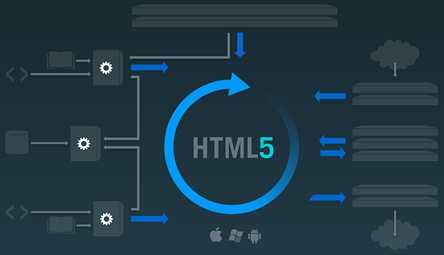HTML 5
Development Company
Your perfect partner to bring startup ideas into life with a full-stack, end-to-end HTML5 development services.
Let’s Discuss
HTML5 is the latest (fifth) version of the popular markup language and the technology that transforms the web, making websites accessible both from mobile and desktop devices. It incorporates 3 types of codes:
As a result, HTML5 eliminates the requirement for additional software. You can watch movies, listen to music, and look up information on the internet, among other things. The language is cross-platform, meaning it works on any netbook, tablet, or Smart TV. It's developer-friendly, so any HTML5 programme will run smoothly and flawlessly. We also don't have to pay any royalties because it's open-source.
The framework toolkit with its rich libraries (like JQuery), multiple handy modules that are easy to customize is beneficial for our talented, experienced developers. It helps us to improve the app performance, using multiple DOM (Document Object Module) elements. The technology is helpful to promote the website’s interactivity, enabling animations, streaming audio and video.
So, we develop Android apps with HTML5 and JavaScript using rich features of both languages..

With the advent of HTML5, it is now possible to build uncompromising financial applications in the browser. The introduction of the HTML5 API narrowed the functionality and performance gap between browser and desktop applications by providing a high speed canvas for data visualization, WebSockets for streaming network communications, a file system API, and more. The list of advantages continues to grow.
Given these advances, the “last mile” for HTML5 is an ability to act as a true desktop application that is indistinguishable from native applications. Chromium Embedded Framework (CEF) is the technology which makes this possible. CEF essentially allows native applications to embed a Chrome browser into their user interface (UI) in a way that is seamless and unapparent to the end user. Thanks to innovations from a few brilliant companies, this technology has been abstracted so that it can now be easily leveraged, both to build new desktop applications and to extend existing applications with HTML5 functionality.

This all sounds great – but only if you’re first convinced that HTML5 offers a unique advantage over traditional programming methods. Native coding (Java, .NET, Objective-C) is alive and well but it is now generally understood that the HTML/CSS paradigm is usually simpler, quicker, and more flexible than traditional native approaches. HTML’s evolution was primarily driven by graphics designers who required flexible layout and complete control over aesthetics in order to build beautiful, mostly print inspired, web pages. The Document Object Model (DOM) and Cascading Style Sheets (CSS) evolved to meet these needs. These technologies were well established by the time browsers gained the ability to present dynamic content. The application of graphic design discipline to dynamic content and interactivity resulted in the web we know today, lush with interfaces that can simultaneously offer power and simplicity.